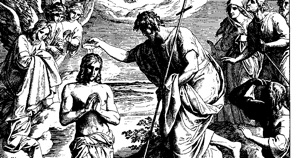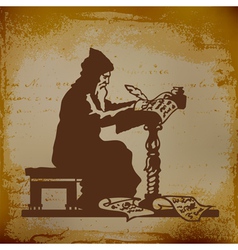This article focuses on the anointing of Jesus (see also, The Way-Gideon).
The Baptizer had already become famous throughout Israel. John preached the basic Essene message of individual repentance for the people and Israel as a nation. For John, national repentance includes the removal of the current Temple Priests, the Sadducees. His message also included repenting from Pharisaic legalism*, and he chastised the scribal authority, those scribes who followed the legalistic imperative to attain righteousness. John denounces Herod the Idumean and Herod’s marriage to his brother’s wife. He attacked Sadducean Temple authority and the rule of law imposed by the Pharisees. He tells the multitudes there is a sinful stain upon the nation (Mt. 3.7).
*Cleansing and purity laws and prayers that accompanied these laws; therein, the diminishment of the spiritual ethos.
To cure this sin stain, John pronounces that repentance must arrive as a change in thinking, essentially an awakening from the legal perspective into a new relationship with God. In preparation for the coming kingdom—”God is witnessing to you,” John asserts. This change in thinking is later reflected by Jesus: “Most assuredly, I say to you, unless one is born again [second birth, awakened], he cannot see the kingdom of God,” as is spoken to Nicodemus in John. 3.3. Thought-change will always remain the fundamental element within conversion. Both John and Jesus preach for a conversion that can only occur by a personal change in whole, a new revelation. The genuine repentance pathway may be delivered from above by the anointing of the Holy Spirit, but always unfolds from within.
*
John points to Jesus as the Messiah.
John’s broader ministry planted a spiritual standard. All matters of consequence, whether good or bad, will first have a standard planted— ‘Here is where I stand and what I stand for!’ John’s message moves past the strict standards of law and asserts revelatory and prophetic speaking.*
*Baptism from teacher to acolyte was the usual practice upon entering a new sect. If we look at the roots of John’s early ministry, immersion represents the cleansing of the old mind and the establishment of a renewed mind. For a religious order to become established, this change must take place. The baptismal is intended to initiate the new man with a different view of the world, himself, and God.
Previous prophets also administered the religious calling of the repentance message. Good references are found in Jer. 18.8-11, Jeremiah’s speaking on God’s power in judging nations—evil for evil and good for good—with repentance the pivotal issue. Joel 2.13 tells us to repent of evil and receive the blessing of a merciful God, much like the message of John the Baptist. Jonah 3, especially verse 10, wherein God sees the penitent works of Nineveh and repents from levying retribution.
John’s omnibus message moves from ritual and sacrifice. The outward demonstration changes into an inward preparation for the Messiah. For the people of Israel, baptism is the direct preparation for the coming Messiah. This baptism is a radical change in thinking compared to waiting and wondering when the Messiah will come. John’s baptism initiates expectancy and preparedness for change—enter baptism and participate in hastening the Messiah! This message conveys the fire and the urgency, as John continues to preach.
As John states in Matthew 3.3, he (John) is the voice crying out to “prepare the way of the Lord.” This preparation is an obscure way to say that the Messiah will bring forth the final message, the final conversion. John arrives first to prepare for the expected order of events in Judaism before the coming of the Messiah.
“While all the people were being immersed, Yeshua too was immersed. As he was praying, heaven was opened; the Ruach HaKodesh (Holy Spirit) came down on him in physical form, like a dove; and a voice came from heaven, ‘You are my Son, whom I love; I am well pleased with you,'” Lk. 3.22.* No one could deny the light that manifested, and by those observing, this experience would have been a witnessing no one would forget.
*The Complete Jewish Study Bible
The Way emphasizes leaving the old way of thinking, often a contrived intellectual slant (legalism or personal legalism). Accepting the precepts into the new way of thinking requires entering the pathway, practicing the path, and being further confirmed. Following John and Jesus’ footsteps, the anointing is a supreme blessing.
.

The power of the anointing would be overwhelming for those who grasped the meaning. People were expecting the Messiah.
Jesus formed his first ministry in Capernaum, where others knew him. He did not begin in a place barren to him, such as Jerusalem.
A person may pray for guidance as to his calling, and the spirit may convict by witnessing from within or demonstrating without. Pentecost anointed 5,000 (without), but how many during Jesus’ ministry received the witnessing quietly (within)? How many were converted by seeing healing or from the word of Jesus’ preachings?
Anointing is a weightier confirmation of an individual’s calling, especially concerning service, teaching, or ministry. The anointing itself may occur before or during a person’s ministry. That ministry may also be what a person does for a living or may pertain to family. A person can sow seed for the spirit to reveal their life mission or may ask to be blessed within a specific discipline. All Children of God are anointed, should they accept it. As you proceed in the Way, be willing to adjust to the spirit working within your calling, of which Jesus is our best demonstration.
News concerning the anointing would spread into Jerusalem within days. Some would travel through smaller villages on the way home, quickly welling up excitement. Others would ask, was this anointing the provocative move of a resurgent religious order? The Pharisees, in particular, would carefully watch. Was John’s more radical preaching signaling the return of a more active Essene priesthood? Was the anointing of Jesus the triumphal ascendancy of a new high priest? These would be disturbing questions for the Pharisees and the Sadducees, and as word of Jesus’s ministry spreads, these concerns would continue to mount.
 The Herodian faction, the Pharisees* who supported Herod, crank up the heat. Herod’s connection to the Sanhedrin remained tightly bound. His power base remained with Sadducaic Temple power and wealth and with Rome.
The Herodian faction, the Pharisees* who supported Herod, crank up the heat. Herod’s connection to the Sanhedrin remained tightly bound. His power base remained with Sadducaic Temple power and wealth and with Rome.
*Some scholars believe the Herodians to be Qumran Essenes. In another view, the Herodians favored Greek custom. They counseled with the Pharisees (Mk. 3.6). They were accusatory toward Jesus, and incited against Jesus for healing the withered arm on the sabbath.
 Now, the clash in consciousness occurs. The people’s view differs from the hierarchical view, illustrated while Jesus is in Bethany, Mt. 21.46, “But when they sought to lay hands on him, they feared for the multitudes, because they took him for a prophet.” By the time Jesus reaches Bethany, the conversion of the people is well underway.
Now, the clash in consciousness occurs. The people’s view differs from the hierarchical view, illustrated while Jesus is in Bethany, Mt. 21.46, “But when they sought to lay hands on him, they feared for the multitudes, because they took him for a prophet.” By the time Jesus reaches Bethany, the conversion of the people is well underway.
For more on anointing, see Gideon. All Children of God may receive an anointing.

God Bless!

I think other website proprietors should take this site as an model, very clean and fantastic user genial style and design, as well as the content. You are an expert in this topic!
This web site is really a walk-via for the entire info you wanted about this and didn’t know who to ask. Glimpse right here, and also you’ll undoubtedly discover it.
After all, what a great site and informative posts, I will upload inbound link – bookmark this web site? Regards, Reader.
Real clean internet site, thanks for this post.